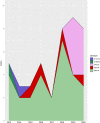Epidemiology and genomic analysis of Shiga toxin-producing Escherichia coli clonal complex 165 in the UK
- PMID: 34919511
- PMCID: PMC8744276
- DOI: 10.1099/jmm.0.001471
Epidemiology and genomic analysis of Shiga toxin-producing Escherichia coli clonal complex 165 in the UK
Abstract
Introduction. Shiga toxin-producing Escherichia coli (STEC) is a zoonotic, foodborne gastrointestinal pathogen that has the potential to cause severe clinical outcomes, including haemolytic uraemic syndrome (HUS). STEC-HUS is the leading cause of renal failure in children and can be fatal. Over the last decade, STEC clonal complex 165 (CC165) has emerged as a cause of STEC-HUS.Gap Statement. There is a need to understand the pathogenicity and prevalence of this emerging STEC clonal complex in the UK, to facilitate early diagnosis, improve clinical management, and prevent and control outbreaks.Aim. The aim of this study was to characterize CC165 through identification of virulence factors (VFs) and antimicrobial resistance (AMR) determinants in the genome and to integrate the genome data with the available epidemiological data to better understand the incidence and pathogenicity of this clonal complex in the UK.Methodology. All isolates belonging to CC165 in the archives at the UK public health agencies were sequenced and serotyped, and the virulence gene and AMR profiles were derived from the genome using PHE bioinformatics pipelines and the Centre for Genomic Epidemiology virulence database.Results. There were 48 CC165 isolates, of which 43 were STEC, four were enteropathogenic E. coli (EPEC) and one E. coli. STEC serotypes were predominately O80:H2 (n=28), and other serotypes included O45:H2 (n=9), O55:H9 (n=4), O132:H2 (n=1) and O180:H2 (n=1). All but one STEC isolate had Shiga toxin (stx) subtype stx2a or stx2d and 47/48 isolates had the eae gene encoding intimin involved in the intimate attachment of the bacteria to the human gut mucosa. We detected extra-intestinal virulence genes including those associated with iron acquisition (iro) and serum resistance (iss), indicating that this pathogen has the potential to translocate to extra-intestinal sites. Unlike other STEC clonal complexes, a high proportion of isolates (93%, 40/43) were multidrug-resistant, including resistance to aminoglycosides, beta-lactams, chloramphenicol, sulphonamides, tetracyclines and trimethoprim.Conclusion. The clinical significance of this clonal complex should not be underestimated. Exhibiting high levels of AMR and a combination of STEC and extra-intestinal pathogenic E. coli (ExPEC) virulence profiles, this clonal complex is an emerging threat to public health.
Keywords: complex STEC infection; haemolytic uraemic syndrome; renal failure; whole-genome sequencing.
Conflict of interest statement
The authors declare that there are no conflicts of interest.
Figures



References
-
- Gasser C, Gautier E, Steck A, Siebenmann RE, Oechslin R. Hemolytic-uremic syndrome: bilateral necrosis of the renal cortex in acute acquired hemolytic anemia. Schweiz Med Wochenschr. 1955;85:905–909. - PubMed
MeSH terms
Substances
LinkOut - more resources
Full Text Sources
Medical
Miscellaneous

